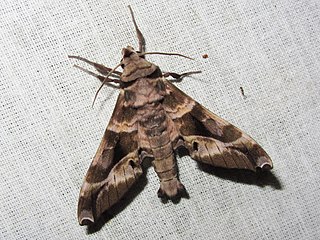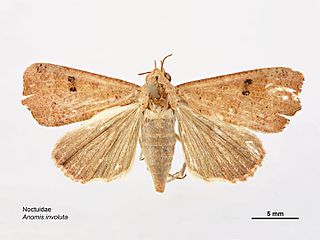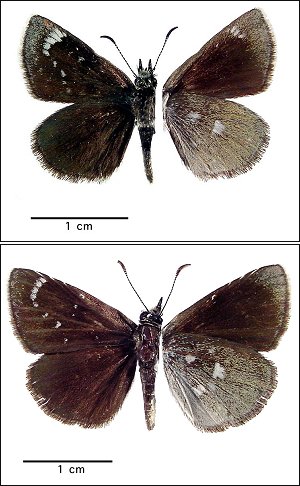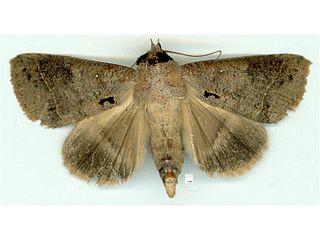
The cabbage moth is primarily known as a pest that is responsible for severe crop damage of a wide variety of plant species. The common name, cabbage moth, is a misnomer as the species feeds on many fruits, vegetables, and crops in the genus Brassica. Other notable host plants include tobacco, sunflower, and tomato, making this pest species particularly economically damaging.

The fairy martin is a member of the swallow family of passerine birds which breeds in Australia. It is migratory wintering through most of Australia, with some birds reaching New Guinea and Indonesia. It is increasingly a wanderer to New Zealand, where it may have bred. This species is frequently placed in the genus Hirundo as Hirundo ariel.

The grayish mouse opossum is a species of opossum endemic to Mexico. It is the sole species in the genus Tlacuatzin.

Belenois java, the caper white or common white, is a small butterfly of the family Pieridae found in Australia, Indonesia, and Melanesia. It is highly migratory and is often confused with the cabbage white.

Pantydia sparsa is a moth of the family Erebidae. It is found in Queensland and on Norfolk Island. This species was introduced to New Zealand in 2004.

Pantydia is a genus of moths in the family Erebidae.

Trigonodes hyppasia, the triangles or semi-looper, is a moth in the family Erebidae. The species was first described by Pieter Cramer in 1779. It is largely cosmopolitan, found throughout Borneo, Fiji, India, Nepal, Sri Lanka, São Tomé and Príncipe, Taiwan, Thailand, Zimbabwe, northern Australia, and almost all African countries.

Craspedortha porphyria is a species of moth of the family Sphingidae.

Anomis involuta, the jute looper or hibiscus cutworm, is a moth of the family Erebidae. It has a wide distribution, including the Cook Islands, Hong Kong, Japan, Korea, the Society Islands and Australia. It is also known from Kenya and Somalia.

Pantydia capistrata is a moth of the family Erebidae. It is found in Fiji, New Guinea and Australia, including New South Wales and Queensland.

Elodina angulipennis is a butterfly in the family Pieridae. It is found along the north-eastern coast of Australia.

Hesperopsis libya, the Mojave sootywing, Mohave sootywing, Great Basin sootywing or Lena sooty wing, is a butterfly of the family Hesperiidae. It is found in North America from eastern Oregon east to Montana and south to southern California, Arizona, and north-western Mexico including Baja California. Its habitats include alkalai flats, sagebrush desert, desert hills, shale barrens, watercourses, and ravines.

Elachista bifasciella is a moth of the family Elachistidae. It is found from Sweden to the Pyrenees, Italy and Romania and from the Netherlands to Poland. It is the type species of the genus Elachista.

Petrophile canescens, commonly known as conesticks, is a species of flowering plant in the family Proteaceae and is endemic to eastern Australia. It is an erect shrub with pinnately-divided leaves and oval heads of hairy, white to pale cream-coloured flowers.
Pantydia diemeni, the gap-lined pantydia, is a species of moth of the family Erebidae. It is found in Australia, where it has been recorded from Tasmania, Queensland, New South Wales, the Australian Capital Territory, Victoria and Western Australia.

Pantydia metaspila is a species of moth of the family Erebidae first described by Francis Walker in 1858. It is found in China, Japan (Ryukyus), India (Maharashtra), Thailand, Taiwan, the Maledives, Sri Lanka, the Philippines, Borneo, Sumatra, Sulawesi, the Tanimbar Islands, Seram, Papua New Guinea, the Caroline Islands, the Solomon Islands, Vanuatu, Fiji, as well as Australia, where it has been recorded from Queensland.
Pantydia metaphaea is a species of moth of the family Erebidae. It is found in Sri Lanka, the Philippines, Borneo, Sumatra and Australia, where it has been recorded from Queensland.

Diploicia canescens is a widespread species of lichenized fungus. It is found throughout much of the world, occurring on every continent except Antarctica.

Neosticta canescens is a species of damselfly in the family Isostictidae, commonly known as a southern pinfly. It can be found in eastern Australia, where it inhabits streams.

Phyla canescens is a species of perennial herbaceous plant in the family Verbenaceae, native to South America. It has been introduced to Australia as an ornamental plant and low-maintenance lawn, but has become naturalised and is considered a serious environmental weed. It is known by several common names including carpet weed, Condamine couch, Condamine curse, fog fruit, frog fruit, hairy fogfruit, lippia, mat grass and no-mow grass.

















